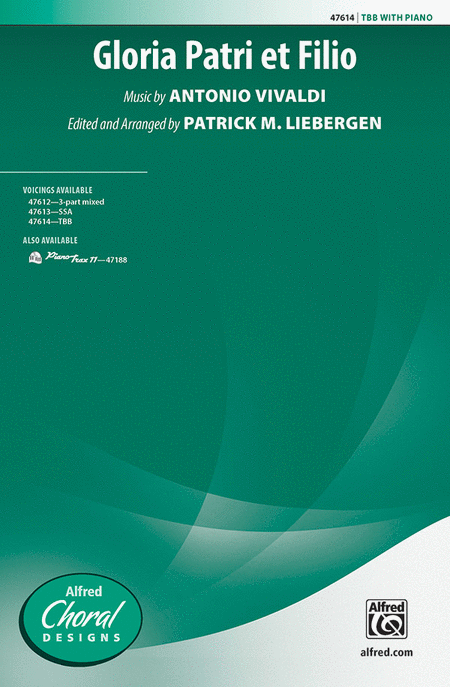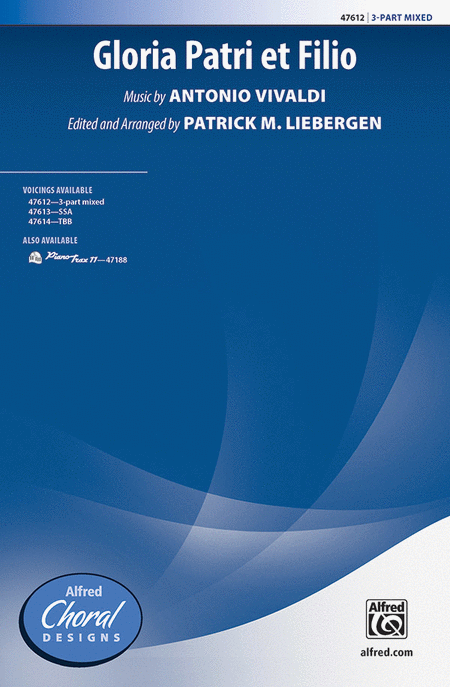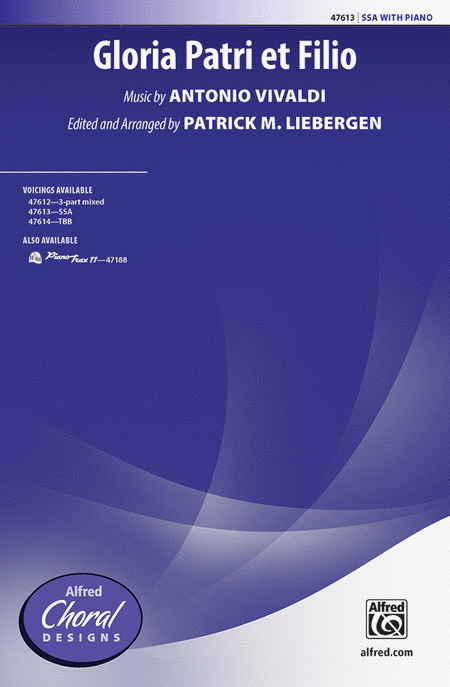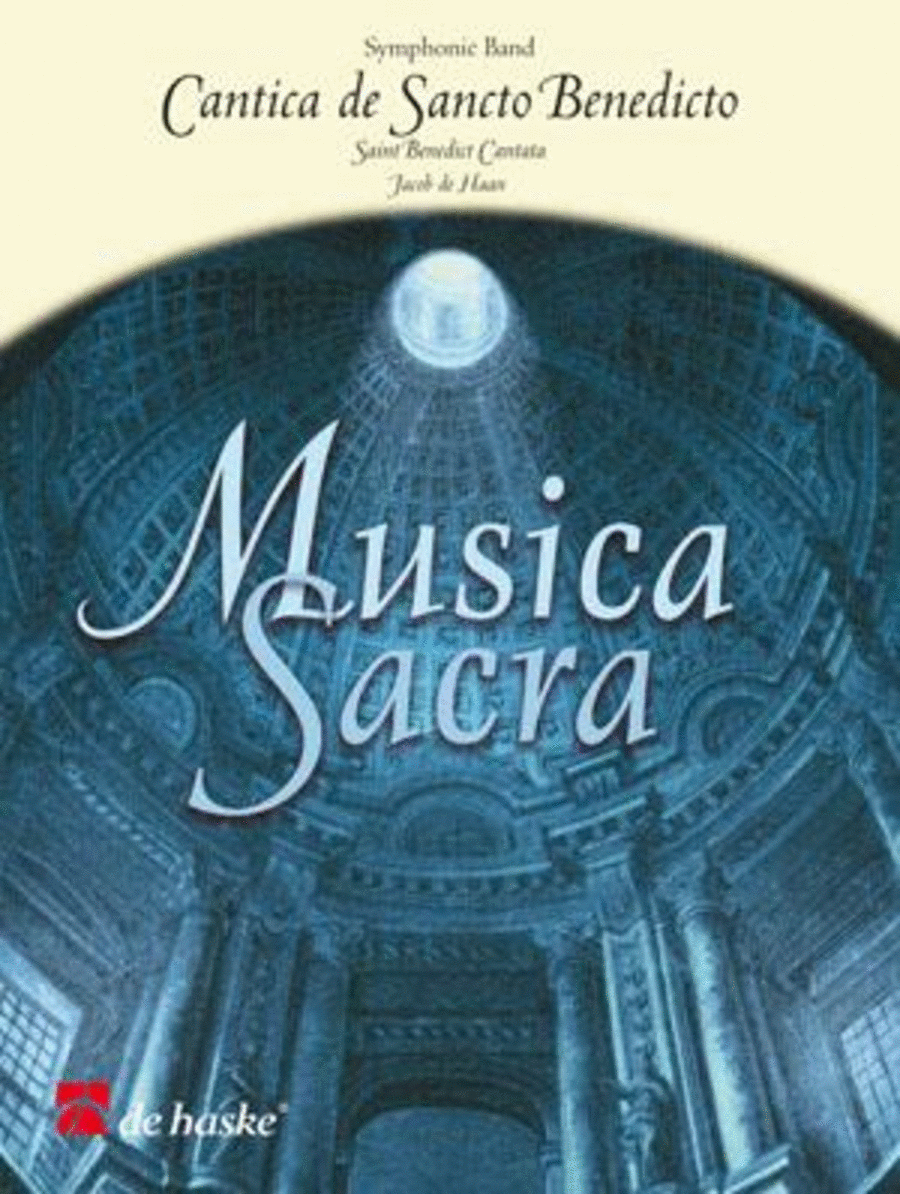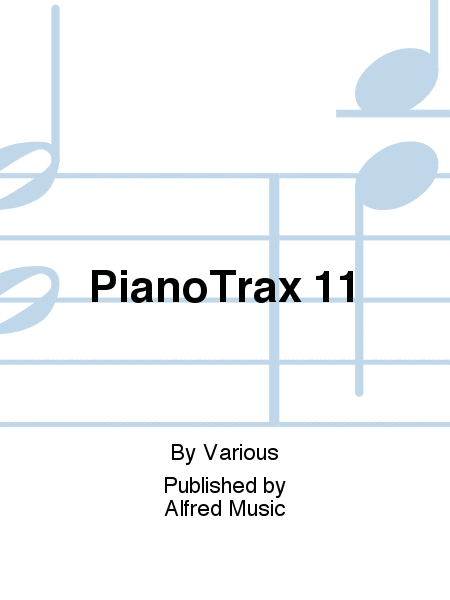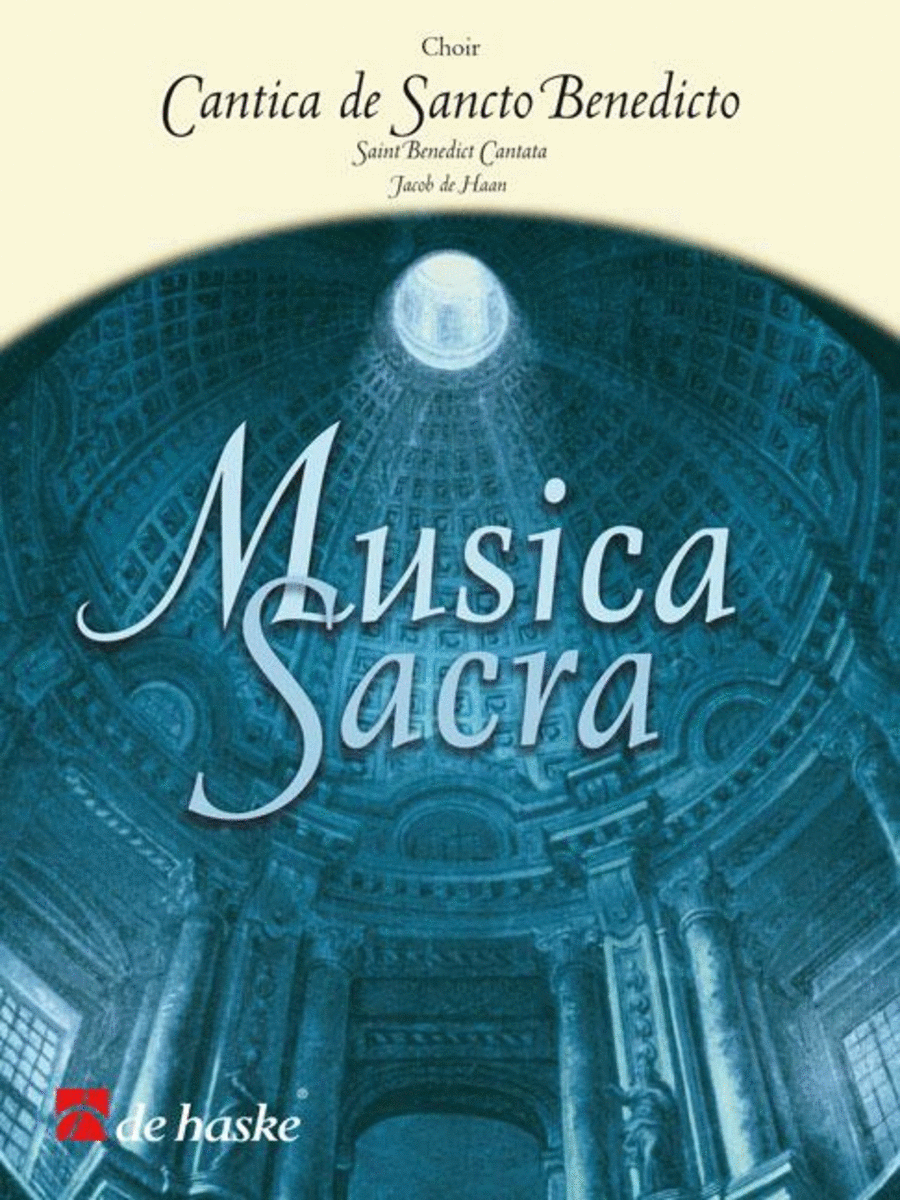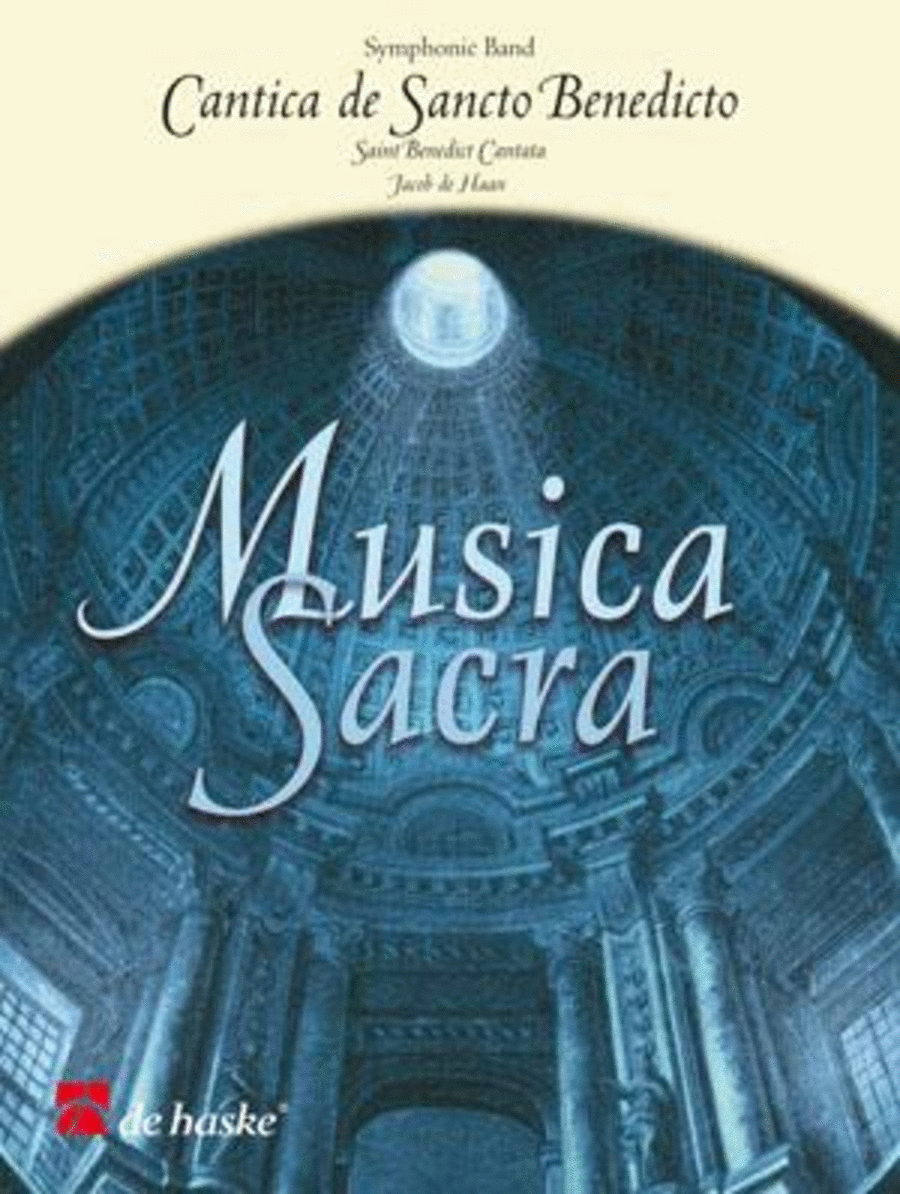|
| Gloria Patri et Filio
Chorale 3 parties
TTB/TBB
Alfred Publishing
Choir (Men's Choir) SKU: AP.47614 Composed by Antonio Vivaldi. Edited by ...(+)
Choir (Men's Choir)
SKU: AP.47614
Composed by Antonio
Vivaldi. Edited by
Patrick M. Liebergen.
Arranged by Patrick M.
Liebergen. Masterworks;
Performance Music
Ensemble; Single Titles.
Alfred Choral Designs.
Baroque; Masterwork
Arrangement; Sacred.
Choral Octavo. 12 pages.
Alfred Music #00-47614.
Published by Alfred Music
(AP.47614). UPC:
038081543079.
English. From
master composer Antonio
Vivaldi's Laetatus Sum (a
setting of Psalm 121),
this edition brings the
brief work to today's
choirs. Featuring an
accessible Latin text and
a lively optional cello
part, this well-crafted
arrangement is an ideal
introduction to many of
the conventions of
Baroque style, including
terraced dynamics and the
alternation between a
small group (or soloist)
and the full
ensemble.
About Alfred
Choral
Designs Th
e Alfred Choral Designs
Series provides student
and adult choirs with a
variety of secular choral
music that is useful,
practical, educationally
appropriate, and a
pleasure to sing. To that
end, the Choral Designs
series features original
works, folk song
settings, spiritual
arrangements, choral
masterworks, and holiday
selections suitable for
use in concerts,
festivals, and
contests. $2.05 - Voir plus => AcheterDélais: 1 to 2 weeks | | | |
| Gloria Patri et Filio
Chorale 3 parties
3 parties Mixtes
Alfred Publishing
Choir (SAB choir/3-Part choir Mixed) SKU: AP.47612 Composed by Antonio Vi...(+)
Choir (SAB choir/3-Part
choir Mixed) SKU:
AP.47612 Composed by
Antonio Vivaldi. Edited
by Patrick M. Liebergen.
Arranged by Patrick M.
Liebergen. Masterworks;
Performance Music
Ensemble; Single Titles.
Alfred Choral Designs.
Baroque; Masterwork
Arrangement; Sacred.
Choral Octavo. 12 pages.
Alfred Music #00-47612.
Published by Alfred Music
(AP.47612). UPC:
038081543055.
English. From
master composer Antonio
Vivaldi's Laetatus Sum (a
setting of Psalm 121),
this edition brings the
brief work to today's
choirs. Featuring an
accessible Latin text and
a lively optional cello
part, this well-crafted
arrangement is an ideal
introduction to many of
the conventions of
Baroque style, including
terraced dynamics and the
alternation between a
small group (or soloist)
and the full
ensemble.
About Alfred
Choral
Designs Th
e Alfred Choral Designs
Series provides student
and adult choirs with a
variety of secular choral
music that is useful,
practical, educationally
appropriate, and a
pleasure to sing. To that
end, the Choral Designs
series features original
works, folk song
settings, spiritual
arrangements, choral
masterworks, and holiday
selections suitable for
use in concerts,
festivals, and
contests. $2.05 - Voir plus => AcheterDélais: 24 hours - In Stock | | | |
| Gloria Patri et Filio
Chorale 3 parties
SSA, Piano
Alfred Publishing
Choir (Women's Choir) SKU: AP.47613 Composed by Antonio Vivaldi. Edited b...(+)
Choir (Women's Choir)
SKU: AP.47613
Composed by Antonio
Vivaldi. Edited by
Patrick M. Liebergen.
Arranged by Patrick M.
Liebergen. Masterworks;
Performance Music
Ensemble; Single Titles.
Alfred Choral Designs.
Baroque; Masterwork
Arrangement; Sacred.
Choral Octavo. 12 pages.
Alfred Music #00-47613.
Published by Alfred Music
(AP.47613). UPC:
038081543062.
English. From
master composer Antonio
Vivaldi's Laetatus Sum (a
setting of Psalm 121),
this edition brings the
brief work to today's
choirs. Featuring an
accessible Latin text and
a lively optional cello
part, this well-crafted
arrangement is an ideal
introduction to many of
the conventions of
Baroque style, including
terraced dynamics and the
alternation between a
small group (or soloist)
and the full
ensemble.
About Alfred
Choral
Designs Th
e Alfred Choral Designs
Series provides student
and adult choirs with a
variety of secular choral
music that is useful,
practical, educationally
appropriate, and a
pleasure to sing. To that
end, the Choral Designs
series features original
works, folk song
settings, spiritual
arrangements, choral
masterworks, and holiday
selections suitable for
use in concerts,
festivals, and
contests. $2.05 - Voir plus => AcheterDélais: 24 hours - In Stock | | | |
| Music from Taize, Volume II
Chorale
GIA Publications
Composed by Jacques Berthier. Taize Community. Sacred. 88 pages. GIA Publication...(+)
Composed by Jacques
Berthier. Taize
Community. Sacred. 88
pages. GIA Publications
#2778. Published by GIA
Publications
(1)$13.00 - Voir plus => AcheterDélais: 24 hours - In Stock | | | |
| Cantica de Sancto Benedicto [Conducteur et Parties séparées] - Intermédiaire
De Haske Publications
Concert Band/Harmonie and Opt. Choir - Grade 4 SKU: BT.DHP-1074334-010 (+)
Concert Band/Harmonie and
Opt. Choir - Grade 4
SKU:
BT.DHP-1074334-010
Saint Benedict
Cantata. Composed by
Jacob De Haan. Musica
Sacra. Concert Piece. Set
(Score & Parts). Composed
2008. De Haske
Publications #DHP
1074334-010. Published by
De Haske Publications
(BT.DHP-1074334-010).
9x12 inches.
English-German-French-Dut
ch. Cantica de
Sancto Benedicto is a
three-movement work for
mixed choir, soprano
solo, concert band and
organ ad libitum - on
Latin lyrics that relate
to the life of Saint
Benedict. It was
commissioned by the city
of Norcia in Italy,
whereBenedict was born.
The holy Benedict
(480-547) is considered
the founder of monastic
life within the Roman
Catholic Church. His
enormous influence is
especially owing to his
monastic rule, the Regula
Benedicti.Jacob de Haan
has named the movements
ofCantica de Sancto
Benedicto after the
Holy Trinity: the Father
(Gloria Patri),
the Son (Gloria
Filio) and the Holy
Spirit (Gloria
Spiritui Sancto). The
lyrics of thehymn
Gemma Caelestis,
(which, like the
othertexts, were
originally used in
Gregorian chant) are
voiced by the choir. To
this purpose, Jacob de
Haan composed new,
choral-like, homophone
music. The sequence
Laeta Quies is
rendered by the soprano;
the verses (divided over
the threemovements) are
alternated with those of
Gemma Caelestis.
The work closes with an
impressive grand finale,
in which texts are used
from the proprium of the
mass in honor of the
saint’s day of the
holy Benedict (11 July).
Notes to the
conductor:For this
cantata, there are
various possibilities for
the performance. The
first involves a
performance in which the
choir and soprano parts
are only accompanied by
organ. Such a performance
has several advantages:
since the band never
soundstogether with the
choir and the soprano, no
balance problems occur,
and even a performance
with a large concert band
and a small cantata choir
is conceivable. A special
layout is also possible -
with which you can set up
a
three-dimensionalperforma
nce in a church. For
example, the choir can
sing in the chancel,
accompanied by the choir
organ; the soprano can
stand on the gallery,
accompanied by the main
organ; and the band can
be seated in another part
of the church. The choir
couldalso sing from a
gallery. With layouts
like this, working with
two conductors is
advisable. Choral parts
available
separately.
Koor
partijen apart
verkrijgbaar.
Cantica de Sancto
Benedicto ist ein
dreisätziges Werk
für gemischten Chor,
Sopran-Solist,
sinfonisches
Blasorchester und Orgel
ad lib. - zu lateinischen
Texten über das Leben
des Heiligen Benedikt. Es
entstand im Auftrag der
italienschen StadtNursia,
dem Geburtsort von
Benedikt. Jacob de Haan
benannte die Sätze von
Cantica de Sancto
Benedicto nach der
Heiligen Dreifaltigkeit:
der Vater (Gloria
Patri), der Sohn
(Gloria Filio) und
der Heilige Geist
(Gloria
SpirituiSancto). Der
Text zur Hymne Gemma
Caelestis (der wie
die übrigen Texte
ursprünglich aus dem
Gregorianischen Choral
stammt) wird vom Chor
gesungen. Zu diesem Zweck
komponierte Jacob de Haan
neue choralartige,
homophone Musik. Der
AbschnittLaeta
Quies wird vom Sopran
vorgetragen; die Strophen
(die sich über alle
drei Sätze verteilen)
wechseln sich mit denen
von Gemma
Caelestis ab. Das
Werk endet mit einem
eindrucksvollen
großartigen Finale, in
dem Texte aus dem
Propriumaus der Messe zu
Ehren des Feiertags des
Heiligen Benedikt (11.
Juli) verwendet
werden.Chorstimmen sind
unter folgendem Link
separat erhältlich:DHP
1074334-050Anmerkungen
für den
Dirigenten:Für
dieseKantate gibt es
mehrere
Aufführungsmöglichk
eiten. Die erste ist eine
Version, in der die Chor-
und Sopranstimmen nur von
der Orgel begleitet
werden. Solch eine
Aufführung bietet
mehrere Vorteile: Da das
Blasorchester nie
zusammen mit Chor und
Sopranerklingt, gibt es
keine Probleme mit der
klanglichen
Ausgewogenheit und sogar
eine Aufführung mit
einem großen
Blasorchester und einem
kleinen Kantatenchor ist
denkbar. Eine besondere
Aufstellung für eine
dreidimensionale
Aufführung in einer
Kircheist ebenso
möglich. Der Chor
singt zum Beispiel von
der Kanzel aus, begleitet
von der Chororgel; der
Sopran steht auf der
Galerie, begleitet von
der Hauptorgel,
während das
Blasorchester in einem
anderen Teil der Kirche
aufgestellt ist. Der Chor
kannauch von Galerie aus
singen. Bei solchen
Aufstellungen ist es
ratsam, mit zwei
Dirigenten zu arbeiten.
Die Begleitung der
Singstimmen ist in
Stichnoten für das
Blasorchester notiert.
Wenn das Werk ohne Orgel
aufgeführt wird,
beispielsweise in
einemKonzertsaal, spielt
das Blasorchester die
Begleitung. Die
Begleitstimmen sind
transparent orchestriert,
zugunsten der klanglichen
Ausgewogenheit von
Blasorchester, Chor und
Sopran. Im dritten Satz
(Takte 144-151) gibt es
eine optionale Passage
fürden Chor. Diese ist
nur für eine
Aufführung mit einem
sehr großen Chor
gedacht. Eine weitere
Variante beinhaltet, den
musikalischen
Höhepunkt im dritten
Satz zu überspringen
und direkt von Takt 156
zu Takt 213
weiterzugehen. Gründe
hierfür könnensein:
der etwas höhere
Schwierigkeitsgrad, eine
begrenzte
Aufführungsdauer
und/oder der Wunsch, den
Kantatentext auf Gemma
Caelestis und
Laeta Quies zu
beschränken.
Während einer Messe
oder eines Gottesdienstes
können auch
verschiedeneStrophen
verwendet werden.
Wahlweise kann das
Sopransolo auch vom
Chorsopran gesungen
werden. Alternativ hierzu
können Sie die
Sopranstimmen (komplett
oder teilweise) von einem
Tenor singen lassen.
Für Chöre, die
Cantica de Sancto
Benedictoaufführen
wollen, bietet der
Komponist einen
Extra-Service auf seiner
Website
https://www.jacobdehaan.c
om, wo Audiodateien der
einzelnen Chorstimmen
für das Einstudieren
zu Hause zugänglich
sind. Informationen zu
anderen Werken für
Chor undBlasorchester
(Missa Brevis und
Missa Katharina)
sind ebenfalls dort zu
finden.Chorstimmen
separat
erhältlich.
<
i>Cantica de Sancto
Benedicto (Cantate
de saint Benoît)
est une Å“uvre en
trois mouvements pour
Soprano, Chœur mixte,
Orchestre
d’Harmonie et
Orgue (ad lib.). Basée
sur des textes en latin
relatant la vie de saint
Benoît, cettecantate
est une Å“uvre de
commande pour la ville de
Nursie en Italie, ville
natale du moine.Benoît
de Nursie ou saint
Benoît (vers 480-547)
est considéré comme
l’initiateur de la
vie monastique dans
l’Église
catholique romaine. Son
immenseinfluence est
essentiellement liée
la rédaction
d’une règle de
vie : la Règle
monastique de saint
Benoît (Regula
Benedicti).Jacob de
Haan a choisi de donner
le nom des troispersonnes
de la Sainte-Trinité
aux trois mouvements de
l’œuvre: le
Père (Gloria Patri/
Gloire au Père),
le Fils (Gloria Filio/
Gloire au Fils) et le
Saint-Esprit (Gloria
Spiritui Sancto/ Gloire
au Saint-Esprit).Le
texte de l’hymne
Gemma Caelestis
(utilisé dans le chant
grégorien
l’instar des
autres textes) est
chanté par le
Chœur sur une musique
de nature homophonique
laquelle le compositeur a
donné un style choral.
La séquence Laeta
Quies est chantée
par la Soprano. La prose
de la séquence est
répartie sur lestrois
mouvements en alternance
avec le texte de
l’hymne latine. Le
finale de
l’œuvre est
impressionnant. Il
développe des textes
du Propre de la Messe en
l’honneur de la
Saint-Benoît,
célébrée le 11
juillet. Partitions pour
chœur disponibles
séparément.
Parti per coro
disponibili a parte. $437.95 - Voir plus => AcheterDélais: 2 to 3 weeks | | | |
| PianoTrax 11
CD Chorale
Alfred Publishing
Choir Secular SKU: AP.47188 Composed by Various. This edition: SoundTrax ...(+)
Choir Secular SKU:
AP.47188 Composed by
Various. This edition:
SoundTrax CD. Choral
Octavo; Performance Music
Ensemble; Single Titles.
Alfred Choral Designs.
Secular. CD. Alfred Music
#00-47188. Published by
Alfred Music (AP.47188).
UPC: 038081540047.
English. PianoTrax
11 CD contains
accompaniment tracks for
the following choral
publications: Adoramus Te
* Benedictus * Beyond *
Calico Cat * Canticum
Novum * Christmas Comes
But Once a Year * Esta
Noche * Ezekiel Saw the
Wheel * Gifts * Gloria
Patri et Filio * Great,
Gettin' Up Day * I Will
Sing You the Stars * If I
Can Sing * In the Pretty
Springtime * Jack and
Jill * Loch Lomond * The
Moon Has a Face *
Nightingale * Sanctus *
Shenandoah * Singers,
Arise! * Topsy-Turvy
World * Veni Jesu * The
Water Is Wide * Winter
Frost * Winter's
Defeat.
About Alfred
Choral
Designs Th
e Alfred Choral Designs
Series provides student
and adult choirs with a
variety of secular choral
music that is useful,
practical, educationally
appropriate, and a
pleasure to sing. To that
end, the Choral Designs
series features original
works, folk song
settings, spiritual
arrangements, choral
masterworks, and holiday
selections suitable for
use in concerts,
festivals, and
contests. $44.99 - Voir plus => AcheterDélais: 1 to 2 weeks | | | |
| Cantica de Sancto Benedicto - Intermédiaire
De Haske Publications
Concert Band/Harmonie and Opt. Choir - Grade 4 SKU: BT.DHP-1074334-050 (+)
Concert Band/Harmonie and
Opt. Choir - Grade 4
SKU:
BT.DHP-1074334-050
Saint Benedict
Cantata. Composed by
Jacob De Haan. Musica
Sacra. Set of Parts.
Composed 2008. De Haske
Publications #DHP
1074334-050. Published by
De Haske Publications
(BT.DHP-1074334-050).
9x12 inches.
English-German-French-Dut
ch. Cantica de
Sancto Benedicto is a
three-movement work for
mixed choir, soprano
solo, concert band and
organ ad libitum - on
Latin lyrics that relate
to the life of Saint
Benedict. It was
commissioned by the city
of Norcia in Italy, where
Benedict was born. The
holy Benedict (480-547)
is considered the founder
of monastic life within
the Roman Catholic
Church. His enormous
influence is especially
owing to his monastic
rule, the Regula
Benedicti.Jacob de Haan
has named the movements
of Cantica de Sancto
Benedicto after the
Holy Trinity: the Father
(Gloria Patri),
the Son (Gloria
Filio) and the Holy
Spirit (Gloria
Spiritui Sancto). The
lyrics of thehymn
Gemma Caelestis,
(which, like the other
texts, were originally
used in Gregorian chant)
are voiced by the choir.
To this purpose, Jacob de
Haan composed new,
choral-like, homophone
music. The sequence
Laeta Quies is
rendered by the soprano;
the verses (divided over
the three movements) are
alternated with those of
Gemma Caelestis.
The work closes with an
impressive grand finale,
in which texts are used
from the proprium of the
mass in honor of the
saint’s day of the
holy Benedict (11 July).
Notes to the conductor:
For this cantata, there
are various possibilities
for the performance. The
first involves a
performance in which the
choir and soprano parts
are only accompanied by
organ. Such a performance
has several advantages:
since the band never
sounds together with the
choir and the soprano, no
balance problems occur,
and even a performance
with a large concert band
and a small cantata choir
is conceivable. A special
layout is also possible -
with which you can set up
a three-dimensional
performance in a church.
For example, the choir
can sing in the chancel,
accompanied by the choir
organ; the soprano can
stand on the gallery,
accompanied by the main
organ; and the band can
be seated in another part
of the church. The choir
could also sing from a
gallery. With layouts
like this, working with
two conductors is
advisable.
Cantica de
Sancto Benedicto ist
ein dreisätziges Werk
für gemischten Chor,
Sopran-Solist,
sinfonisches
Blasorchester und Orgel
ad lib. - zu lateinischen
Texten über das Leben
des Heiligen Benedikt. Es
entstand im Auftrag der
italienschen Stadt
Nursia, dem Geburtsort
von Benedikt. Jacob de
Haan benannte die
Sätze von Cantica
de Sancto Benedicto
nach der Heiligen
Dreifaltigkeit: der Vater
(Gloria Patri),
der Sohn (Gloria
Filio) und der
Heilige Geist (Gloria
Spiritui Sancto). Der
Text zur Hymne Gemma
Caelestis (der wie
die übrigen Texte
ursprünglich aus dem
Gregorianischen Choral
stammt) wird vom Chor
gesungen. Zu diesem Zweck
komponierteJacob de Haan
neue choralartige,
homophone Musik. Der
Abschnitt Laeta
Quies wird vom Sopran
vorgetragen; die Strophen
(die sich über alle
drei Sätze verteilen)
wechseln sich mit denen
von Gemma
Caelestis ab. Das
Werk endet mit einem
eindrucksvollen
großartigen Finale, in
dem Texte aus dem
Proprium aus der Messe zu
Ehren des Feiertags des
Heiligen Benedikt (11.
Juli) verwendet
werden.Link zur Partitur:
DHP
1074334-140Link zum
Blasorchesterset: DHP
1074334-010
La partie de
Soprano solo peut être
confiée
l’ensemble des
sopranos du Chœur.
Une autre alternative
serait de faire chanter
la partie de Soprano,
partiellement ou
entièrement, par un
Ténor.Pour faciliter
le travail ( domicile)
des choristes, le
compositeur tient leur
disposition des fichiers
audio de chaque partie
vocale. Pour obtenir ces
fichiers, il suffit de
consulter le site
www.jacobdehaan.com.Ca
ntica de Sancto
Benedicto (Cantate
de saint Benoît)
est une œuvre en
trois mouvements pour
Soprano, Chœur
mixte, Orchestre
d’Harmonie et
Orgue (ad lib.). Basée
sur des textes en latin
relatant la vie de saint
Benoît, cette cantate
est uneœuvre de
commande pour la ville de
Nursie en Italie, ville
natale du moine.Benoît
de Nursie ou saint
Benoît (vers 480-547)
est considéré comme
l’initiateur de la
vie monastique dans
l’Église
catholique romaine. Son
immense influence est
essentiellement liée
la rédaction
d’une règle de
vie : la Règle
monastique de saint
Benoît (Regula
Benedicti).Jacob de
Haan a choisi de donner
le nom des trois
personnes de la
Sainte-Trinité aux
trois mouvements de
l’œuvre : le
Père (Gloria Patri/
Gloire au Père),
le Fils (Gloria Filio/
Gloire au Fils) et le
Saint-Esprit (Gloria
Spiritui Sancto/ Gloire
au Saint-Esprit).Le
texte de l’hymne
Gemma Caelestis
(utilisé dans le chant
grégorien
l’instar des
autres textes) est
chanté par le
Chœur sur une
musique de nature
homophonique laquelle le
compositeur a donné un
style choral. La
séquence Laeta
Quies est chantée
par la Soprano. La prose
de la séquence est
répartie sur les trois
mouvements en alternance
avec le texte de
l’hymne latine. Le
finale de
l’œuvre est
impressionnant. Il
développe des textes
du Propre de la Messe en
l’honneur de la
Saint-Benoît,
célébrée le 11
juillet. $78.95 - Voir plus => AcheterDélais: 2 to 3 weeks | | | |
| Cantica de Sancto Benedicto [Conducteur] - Intermédiaire
De Haske Publications
Concert Band/Harmonie and Opt. Choir - Grade 4 SKU: BT.DHP-1074334-140 (+)
Concert Band/Harmonie and
Opt. Choir - Grade 4
SKU:
BT.DHP-1074334-140
Saint Benedict
Cantata. Composed by
Jacob De Haan. Musica
Sacra. Score Only.
Composed 2008. De Haske
Publications #DHP
1074334-140. Published by
De Haske Publications
(BT.DHP-1074334-140).
9x12 inches.
English-German-French-Dut
ch. Cantica de
Sancto Benedicto is a
three-movement work for
mixed choir, soprano
solo, concert band and
organ ad libitum - on
Latin lyrics that relate
to the life of Saint
Benedict. It was
commissioned by the city
of Norcia in Italy,
whereBenedict was born.
The holy Benedict
(480-547) is considered
the founder of monastic
life within the Roman
Catholic Church. His
enormous influence is
especially owing to his
monastic rule, the Regula
Benedicti.Jacob de Haan
has named the movements
ofCantica de Sancto
Benedicto after the
Holy Trinity: the Father
(Gloria Patri),
the Son (Gloria
Filio) and the Holy
Spirit (Gloria
Spiritui Sancto). The
lyrics of thehymn
Gemma Caelestis,
(which, like the
othertexts, were
originally used in
Gregorian chant) are
voiced by the choir. To
this purpose, Jacob de
Haan composed new,
choral-like, homophone
music. The sequence
Laeta Quies is
rendered by the soprano;
the verses (divided over
the threemovements) are
alternated with those of
Gemma Caelestis.
The work closes with an
impressive grand finale,
in which texts are used
from the proprium of the
mass in honor of the
saint’s day of the
holy Benedict (11 July).
Notes to the
conductor:For this
cantata, there are
various possibilities for
the performance. The
first involves a
performance in which the
choir and soprano parts
are only accompanied by
organ. Such a performance
has several advantages:
since the band never
soundstogether with the
choir and the soprano, no
balance problems occur,
and even a performance
with a large concert band
and a small cantata choir
is conceivable. A special
layout is also possible -
with which you can set up
a
three-dimensionalperforma
nce in a church. For
example, the choir can
sing in the chancel,
accompanied by the choir
organ; the soprano can
stand on the gallery,
accompanied by the main
organ; and the band can
be seated in another part
of the church. The choir
couldalso sing from a
gallery. With layouts
like this, working with
two conductors is
advisable. Choral parts
available
separately.
Koorpa
rtijen apart
verkrijgbaar.
C
antica de Sancto
Benedicto ist ein
dreisätziges Werk
für gemischten Chor,
Sopran-Solist,
sinfonisches
Blasorchester und Orgel
ad lib. - zu lateinischen
Texten über das Leben
des Heiligen Benedikt. Es
entstand im Auftrag der
italienschen StadtNursia,
dem Geburtsort von
Benedikt. Jacob de Haan
benannte die Sätze von
Cantica de Sancto
Benedicto nach der
Heiligen Dreifaltigkeit:
der Vater (Gloria
Patri), der Sohn
(Gloria Filio) und
der Heilige Geist
(Gloria
SpirituiSancto). Der
Text zur Hymne Gemma
Caelestis (der wie
die übrigen Texte
ursprünglich aus dem
Gregorianischen Choral
stammt) wird vom Chor
gesungen. Zu diesem Zweck
komponierteJacob de Haan
neue choralartige,
homophone Musik. Der
AbschnittLaeta
Quies wird vom Sopran
vorgetragen; die Strophen
(die sich über alle
drei Sätze verteilen)
wechseln sich mit denen
von Gemma
Caelestis ab. Das
Werk endet mit einem
eindrucksvollen
großartigen Finale, in
dem Texte aus dem
Propriumaus der Messe zu
Ehren des Feiertags des
Heiligen Benedikt (11.
Juli) verwendet werden.
Chorstimmen separat
erhältlich.
Cantica de
Sancto Benedicto
(Cantate de saint
Benoît) est une
œuvre en trois
mouvements pour Soprano,
Chœur mixte,
Orchestre
d’Harmonie et
Orgue (ad lib.). Basée
sur des textes en latin
relatant la vie de saint
Benoît, cettecantate
est une œuvre de
commande pour la ville de
Nursie en Italie, ville
natale du moine.Benoît
de Nursie ou saint
Benoît (vers 480-547)
est considéré comme
l’initiateur de la
vie monastique dans
l’Église
catholique romaine. Son
immenseinfluence est
essentiellement liée
la rédaction
d’une règle de
vie : la Règle
monastique de saint
Benoît (Regula
Benedicti).Jacob de
Haan a choisi de donner
le nom des troispersonnes
de la Sainte-Trinité
aux trois mouvements de
l’œuvre: le
Père (Gloria Patri/
Gloire au Père),
le Fils (Gloria Filio/
Gloire au Fils) et le
Saint-Esprit (Gloria
Spiritui Sancto/ Gloire
au Saint-Esprit).Le
texte de l’hymne
Gemma Caelestis
(utilisé dans le chant
grégorien
l’instar des
autres textes) est
chanté par le
Chœur sur une
musique de nature
homophonique laquelle le
compositeur a donné un
style choral. La
séquence Laeta
Quies est chantée
par la Soprano. La prose
de la séquence est
répartie sur lestrois
mouvements en alternance
avec le texte de
l’hymne latine. Le
finale de
l’œuvre est
impressionnant. Il
développe des textes
du Propre de la Messe en
l’honneur de la
Saint-Benoît,
célébrée le 11
juillet. Partitions pour
chœur disponibles
séparément.
Parti per coro
disponibili a parte. $90.95 - Voir plus => AcheterDélais: 2 to 3 weeks | | |
|
